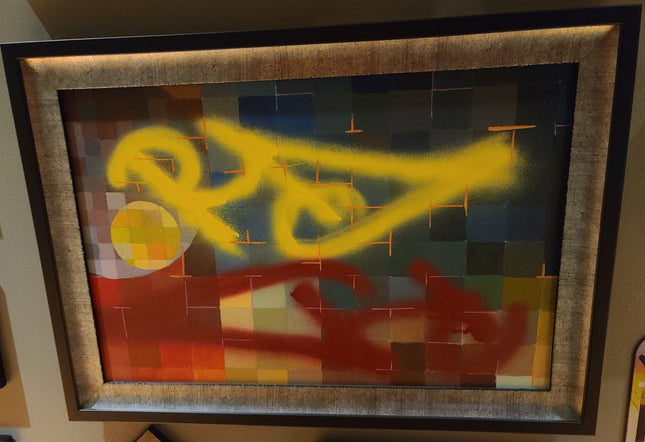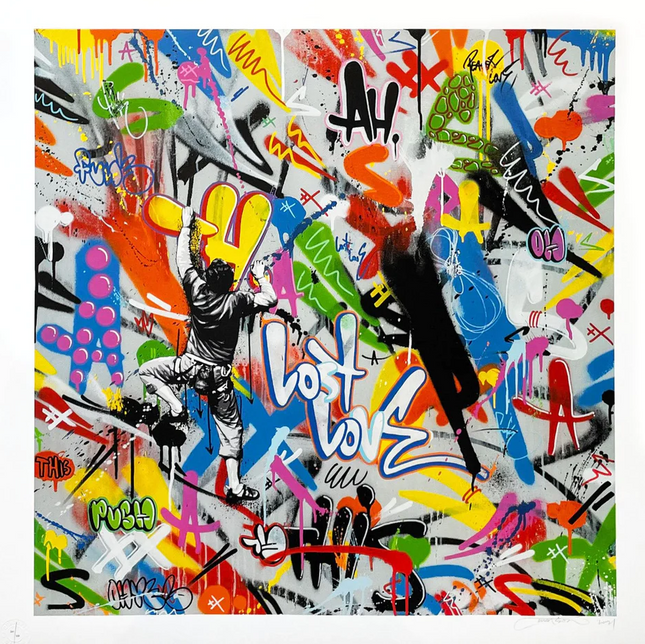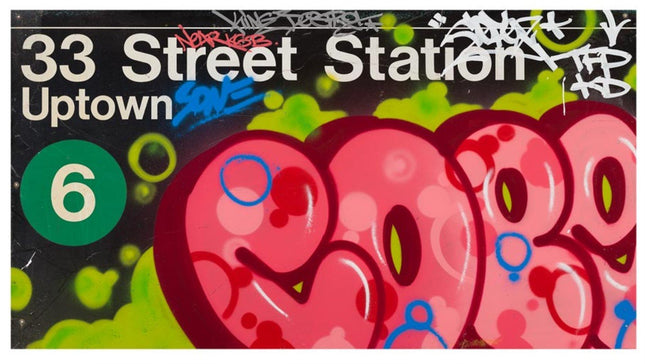
Street Art
-

RD-357 Real Deal Abstract Cubism 1 Original Acrylic Spray Paint Painting by RD-357 Real Deal
Abstract Cubism 1 Original One of a Kind Mixed Media Spray Paint Acrylic Painting Artwork on Stretched Canvas by Popular Street Graffiti Artist RD-357. Custom Framed 31.5x22.5. Abstract Cubism 1 by RD-357 Painting- This original artist's stretched canvas mixed media spray paint graffiti painting features the RD tag with cubsitic colors in the background. Awesome rare original canvas art by prolific street artist Real Deal RD357.
$2,607.00 $2,216.00
-

Martin Whatson Rock Climber PP Giclee Silkscreen Print by Martin Whatson
Rock Climber PP Giclee Silkscreen Print by Martin Whatson Printers Proof Hand-Pulled 18-Color Screen Print on 300gsm Somerset Fine Art Paper Limited Edition Pop Street Artwork & Graffiti. PP Printers Proof 2021 Signed & Marked P/P Limited Edition Run Artwork Size 31.5x31.5 Giclee Over Silkscreen Print. Martin Watson Artistic Approach "Rock Climber PP" is a giclée and silkscreen print by Martin Whatson, a notable figure in contemporary street pop art and graffiti. As a Printer's Proof (PP) from a limited edition run in 2021, this piece captures the dynamic essence of urban art. Signed and marked by the artist, "Rock Climber PP" spans 31.5 inches by 31.5 inches and showcases Whatson's adeptness in blending giclée precision with the rawness of hand-pulled screen printing. Martin Whatson's art is recognized for its vivid portrayal of motion and emotion, often juxtaposed against a monochrome background. In "Rock Climber PP," Whatson employs an 18-color screen print on 300gsm Somerset fine art paper, a medium well-regarded for its texture and durability, which is crucial for the layered technique used in the work. The artwork is distinguished by its hand-pulled screen printing method, which ensures that each color layer is applied with personal attention, contributing to the print's depth and vibrancy. Convergence of Techniques in "Rock Climber PP" The combination of giclée and silkscreen print in "Rock Climber PP" exemplifies the convergence of digital precision and traditional printmaking. Giclée prints are known for their high-resolution and sharp detail, derived from digital printing. This modern technique allows for the gradations and nuances of the original artwork to be captured with exceptional clarity. On the other hand, silkscreen printing is a manual process that involves forcing ink through a mesh screen to create an image. It's a method deeply rooted in the history of street art and pop art due to its directness and capacity for bold, saturated colors. Cultural Impact of Watson's Work "Rock Climber PP" is more than a mere amalgamation of techniques; it is a visual narrative that speaks to the urban experience and its inherent search for meaning. The figure of the rock climber, striving upward amidst the chaotic splashes of color, symbolizes the human quest for progress and the challenges faced in the climb. This imagery represents street pop art's core themes: struggle, resilience, and the beauty found in the act of creation. The Significance of Limited Edition Prints As a Printer's Proof, "Rock Climber PP" holds a special place in collectible art. The printer or artist typically retains these proofs and are not part of the numbered edition, making them rarer than the standard prints. Collectors highly prize them for their exclusivity and the insight they provide into the artist's process. In addition, Watson's signature and the PP mark on the artwork seal authenticity, further elevating the print's value and desirability. In conclusion, "Rock Climber PP" by Martin Watson stands as a vibrant embodiment of the street pop art and graffiti movement. It captures the essence of urban art through the interplay of giclée and silkscreen techniques, resulting in an intricate and explosive piece. The print is a testament to Whatson's skillful navigation of art forms and ability to convey profound messages through his distinctive visual language. This artwork resonates with the energy of the streets and the spirit of contemporary art, encapsulating the genre's vitality.
$4,376.00
-

Cope2- Fernando Carlo 33rd Street Station Archival Print by Cope2- Fernando Carlo
33rd Street Station Archival Pigment Fine Art Limited Edition Print on 290gsm Moab Entrada Paper by Modern Pop Street Graffiti Artist Cope2. Signed & Numbered Archival Pigment Print on 290gsm Moab Fine Art Paper Size: 31.5 x 18 Inches Release: March 11, 2020 Run of: 100 Cope2 has always shown his respect for the writers before him and in his first steps in the world of graffiti, he was interested in learning from them. This is the way he described his first encounter with them in an interview with Widewalls in 2006: “When I started, to see these graffitis one subway cars was great – the colors, the letters – I wanted to learn from the original artists, not just copy. New York is the motherland of graffiti, I am part of the second generation and I wanted to get my special style.”
$352.00




